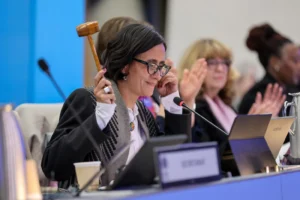Australia is heading to the polls for a general election on 3 May.
The ruling centre-left Labor party has for the past three years attempted to fix Australia’s “climate-laggard” reputation by setting a legal net-zero target and approving a record number of renewable energy projects.
Prime minister Anthony Albanese is also hoping, if reelected, to stave off Turkey to host the COP31 climate summit in Adelaide, South Australia, in 2026.
However, the Labor party has faced criticism from climate analysts for approving new coal mines and expansions and pledging support for new gas projects until “beyond 2050”.
Labor’s main opposition, the Liberal-National Coalition, an alliance of right-leaning parties, hopes to reenter power on a plan centred around building seven nuclear power plants across the country.
Australia currently has no nuclear power.
The Coalition has also pledged to “ramp up” domestic gas production, slow the rollout of renewables and keep coal-fired power plants open for longer.
Its leader, Peter Dutton, has said that hosting COP31 would be “madness” and cost “tens of billions” of dollars.
In contrast to the two major parties, Australia’s Greens have policies to stop new coal and gas projects, end fossil fuel subsidies and instead pay homes and businesses to install solar and batteries.
Voting is compulsory in Australia.
Its preferential voting system will all but guarantee that one of the two major parties will enter power.
Current polling suggests that Labor will edge ahead of the Coalition to win the election, after preferences are distributed between the top two parties.
In the interactive grid below, Carbon Brief examines where Australian parties stand on climate change, energy and nature.
Each entry in the grid represents a direct quote from a party document.
The piece will be updated to include the Labor Party’s full plans once they have been announced.
Coal and campaigning
Australia is the third-largest exporter of fossil fuels in the world. Coal accounts for three-quarters of the nation’s total exports.
From 2021-22, Australia produced 422m tonnes of coal. When burned, this will create 1.1bn tonnes of carbon dioxide equivalent (CO2e).
Australia’s richest citizen, Gina Rinehart, makes her fortune from coal mining and is a supporter of climate-sceptic groups and a friend of Donald Trump.
Her company, Hancock Prospecting, is now the Coalition’s second-largest donor.
Coalition leader Dutton was forced to clarify that he believed in climate change after refusing to comment on the increasing impacts of warming during a TV debate with Albanese.
Newspaper magnate Rupert Murdoch rules over 60% of Australia’s print media through his company News Corp. He has been accused of using his media empire to sow “confusion and doubt” about climate change.
Biodiversity crisis
Australia is also one of the world’s 17 “megadiverse” countries, meaning it is home to some of Earth’s most rare, unique and abundant wildlife. It is one of just two developed countries to have this status, alongside the US.
The nation is facing a species extinction crisis. The Great Barrier Reef, Earth’s largest living structure, is projected to die off if the world does not meet its climate goals.
The logging of natural forests is still permitted in several Australian states, including Tasmania, New South Wales and Queensland.
Both of the major parties have been criticised for failing to centre the biodiversity crisis in their campaigning.
By contrast, the Greens have pledged to spend 1% of the budget on nature, end native forest logging nationally and spend $20bn on biodiversity restoration over the next decade.
The post Australia election 2025: Where parties stand on climate change, energy and nature appeared first on Carbon Brief.





